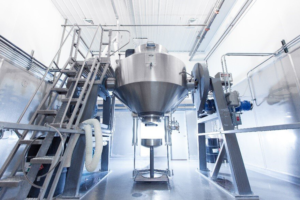
Speaking the language of powder attributes and material handling
Mike Edwards
Features GEMCO material handling pharmaceuticals powders A DOUBLE-EDGED SWORD: Manufacturers need to deal with excess external moisture in raw powder materials before it becomes inbound moisture, but if the level is too low in
a raw material powder input, it could negatively affect blending, especially in pharmaceutical production processes.
A DOUBLE-EDGED SWORD: Manufacturers need to deal with excess external moisture in raw powder materials before it becomes inbound moisture, but if the level is too low in
a raw material powder input, it could negatively affect blending, especially in pharmaceutical production processes. In industries such as cosmetics, pharmaceuticals, nutraceuticals, additive metals and plastics, the precise mixing and drying of powders can be critical to the colour, consistency, performance, safety, and cost effectiveness of a wide range of products.
A host of variables, such as powder size, shape, density, chemistry, static charge, and moisture content can determine successful formulation. Because these variables can change during the supply chain, it is essential for manufacturers to consult powder specialists that essentially “speak the language of powders” – who can look at the entire process to help optimize product quality and the production process.
Failing to do so can lead to sub-par product, potential failure in the field, and an array of inefficient efforts during production that attempt to correct deficiencies but do not address the root causes.
In regards to raw powder ingredients, if a manufacturer does not know which factors must be within specification and what the specs should be, an operator can spend hours or days reworking the batch trying to get it right when guesswork alone may not resolve an issue, according to Casey Muench Bickhardt, president of Gemco, a Middlesex, NJ-based manufacturer of tumble blending and vacuum tumble-drying equipment.
“If a manufacturer using powdered materials does not take the time to look at the raw ingredients to ensure that they are properly prepared for a mix, an operator often may just try blending the ingredients longer, faster or with greater force,” says Bickhardt.
“More or less liquid may be added. More processing equipment may be added to the process train. All this guesswork and experimentation adds cost and complexity to production. However, guesswork plus a trial and error approach to problem solving is time consuming and seldom achieves the desired results.”
Instead, powder mixing/drying of raw ingredients and chemicals requires a strategy and knowledge of powder chemistry and physics that ensures manufacturers achieve the same desired results every time.
“Having such a strategy along with specialized consultative powder expertise on hand is like knowing the answers to a test before taking it,” says Bickhardt. “For manufacturers, a more scientific approach provides confidence that they will reliably and consistently achieve their production and final product goals.”
The benefits of engaging in a consultative process for powdered ingredients are numerous. This includes expedited product development and market entry, along with enhanced product quality and streamlined production, with tighter specification and control over raw materials and the elimination of rework. As such, the savings in materials, labor, and time spent on quality control issues can be significant.
Examining the Factors in Powder/Product Quality
To cost effectively mix powders to achieve a quality product requires reviewing factors such as powder size, shape, density, chemistry, and moisture content.
Powder Size, Shape and Density
When powders with different particle sizes are mixed, the larger particles will leave a space or gap where smaller particles may “fall out,” making the blend difficult to keep together.
Alternatively, powder particles can come in various irregular shapes that can lead to particles interlocking or clumping that must be broken up to achieve uniformity.
Dissimilar powder density is also an issue that must be resolved for different powders to blend homogenously.
To help mix and balance particles with dissimilar size, shape or density, Bickhardt recommends using a combination of macro and micro blending that produces a better distribution. Macro mixing is achieved by rotating the shaped vessel, allowing the material bed to fall away from the vessel’s walls. The blender moves at a precise speed, with the vessel wall at a precise angle, so that the material cascades over itself.
While this occurs, micro mixing (if needed) simultaneously proceeds via agitator blades located in the mixing zone center of the vessel, where fine processing in the material transpires. Together, the macro and micro mixing evenly expose each particle to six times more active blending per revolution than traditional mixers.
Powder Chemistry
Another critical factor that manufacturers need to understand to achieve quality blends and products is powder chemistry.
“For different powder particles, it is critical to understand the chemical characteristics of the particles,” says Bickhardt. “You could be looking at how they form chemical bonds, if they are polar or non-polar, etc. It is essential to pay attention to the science to get the powders fundamentally prepared to be blended.”
According to Bickhardt, understanding the chemistry of the raw powder ingredients to be mixed is vital for any time-release technologies, enrobing (enabling a powder coating to accumulate as it contacts other particles in a controlled process), and hydrophilic (tending to mix with/dissolve in water), or hydrophobic (tending to repel/not mix with water) coatings.
Static

A vacuum tumble dryer can scientifically control heat input, vacuum and powder flow which gives manufacturers a consistent and predictable drying cycle. As a closed system, dangerous solvents can be captured.
Finding out if powder particles may be affected by a static electrical charge is also essential and must be addressed in the blending units, according to Bickhardt.
“If you have powder particles that will be polarized by static electricity or any charge, then you literally have forces working inside the mixer that will compete against a good mix,” says Bickhardt. “In such cases, it is important to equip the unit with static electricity arresters.”
Moisture Content
Powder mixing and drying in particular will be affected by the presence of moisture in raw ingredients, which must be monitored and controlled to optimize the purchase price, processing, and end product.
“If moisture levels are too high in a raw ingredient, the manufacturer is overpaying for excess water that must be removed by extended drying,” says Bickhardt.
According to Bickhardt, manufacturers absolutely want to deal with excess external moisture in raw powder materials before it becomes inbound moisture.
“Once water is trapped inside a powder particle, you need exponentially more vacuum and heat directed inwards to remove inbound moisture than with surface moisture,” says Bickhardt.
On the other hand, if the moisture level is too low in a raw material powder input, it could negatively affect blending and end product performance which can be critical, particularly for regulated products like pharmaceuticals.
“So, it is really important to measure both moisture content and loss on drying,” says Bickhardt, whose company offers testing from a full analytical lab and provides consulting from on staff process and chemical engineers.
Ensuring Raw Input Consistency
Bickhardt adds that in addition to the science behind mixing and drying powders, an unanticipated benefit of a consultative approach is helping manufacturers to identify and resolve issues with raw ingredient suppliers that may also affect the final product.
In terms of powder, raw material inputs can have variations in size, shape, density, etc. This can cause clumping and granulation, for instance, that results in improper mixing and drying. Left unaddressed, this can lead to end product quality problems, involving diminished performance, aesthetics, durability, and safety in industries like cosmetics, pharmaceuticals, and automotive paints.
“If there are issues with raw ingredients there could be strategies to decrease particle size and remove oversize particles, such as by screening them out,” says Bickhardt. “But getting needed expertise on their raw materials ahead of time is an exponentially better approach because holding to tighter specifications and quality controls over their raw materials from suppliers will essentially eliminate rework in the plant.”
In addition, changes in temperature, moisture, and environment can affect powdered materials at all stages of the supply chain. However, a consultative approach will evaluate these areas as well.
“Controlling all stages of the supply chain and production is critical to achieve a quality end product reliably and consistently,” concludes Bickhardt. “But that starts with having the raw ingredient evaluated to see if it meets all necessary requirements and specifications, and it involves expert consultation as needed with powder specialists.”
This article was contributed by Gemco.
Print this page